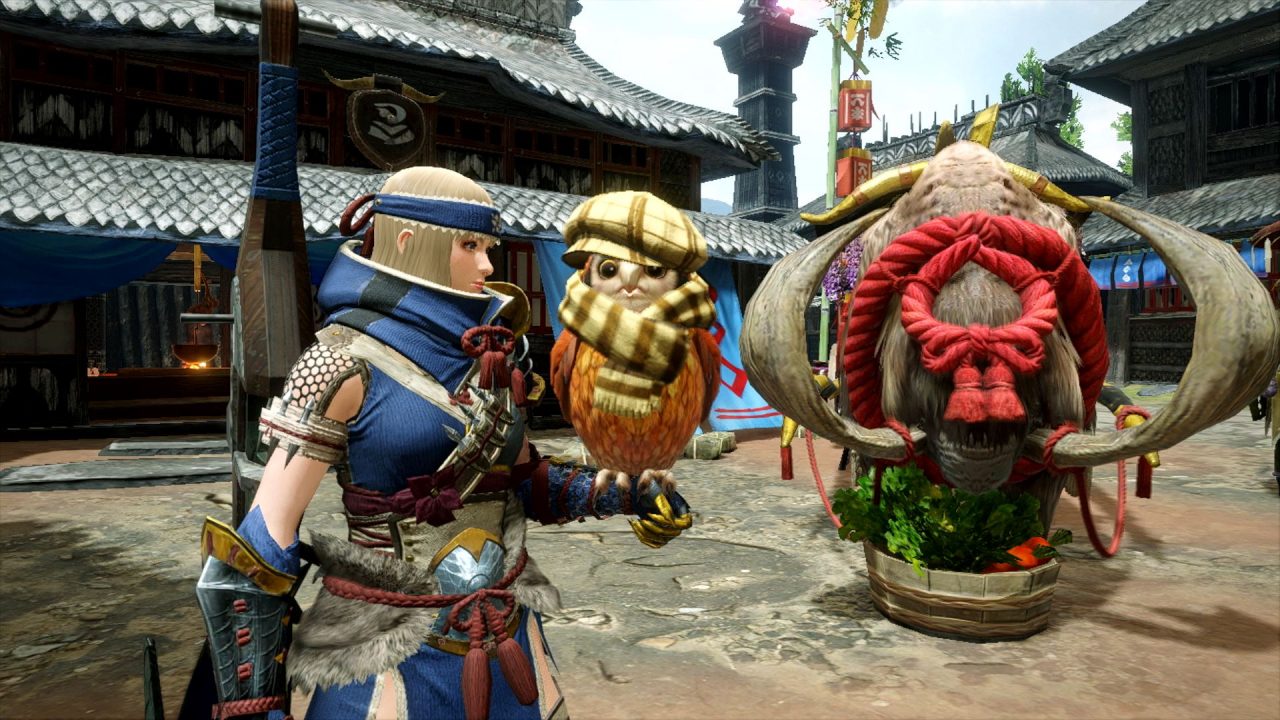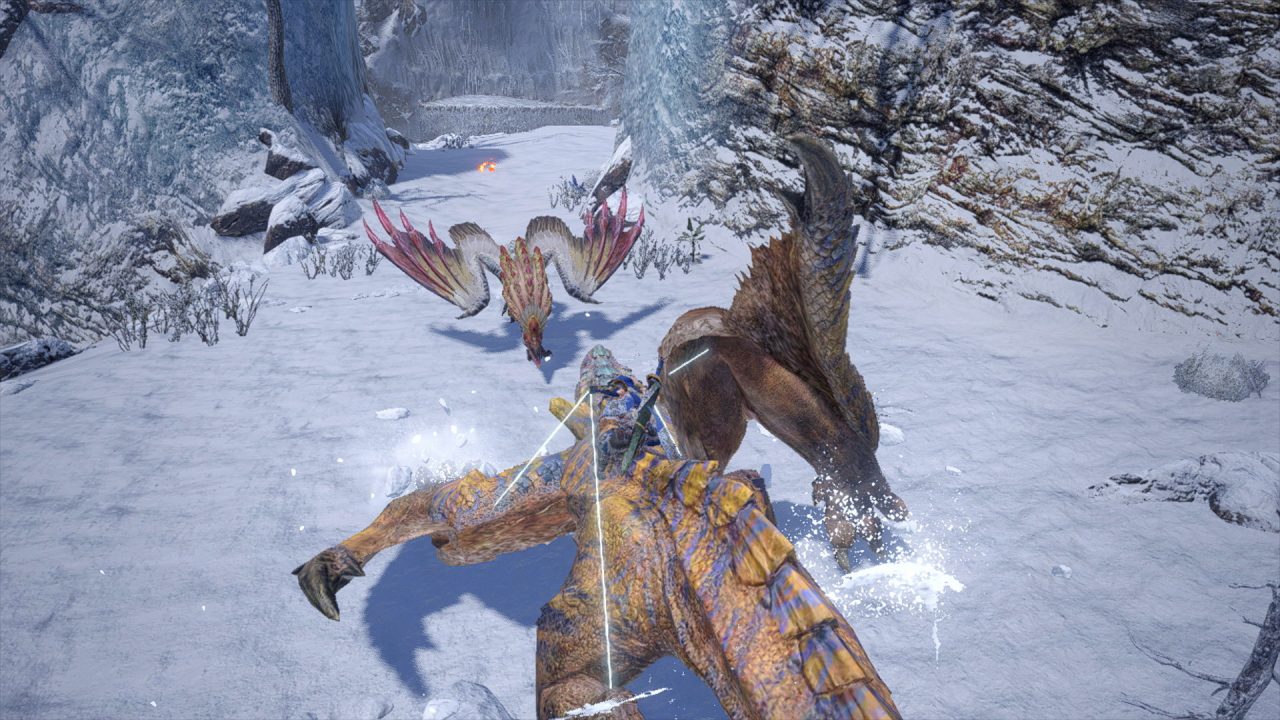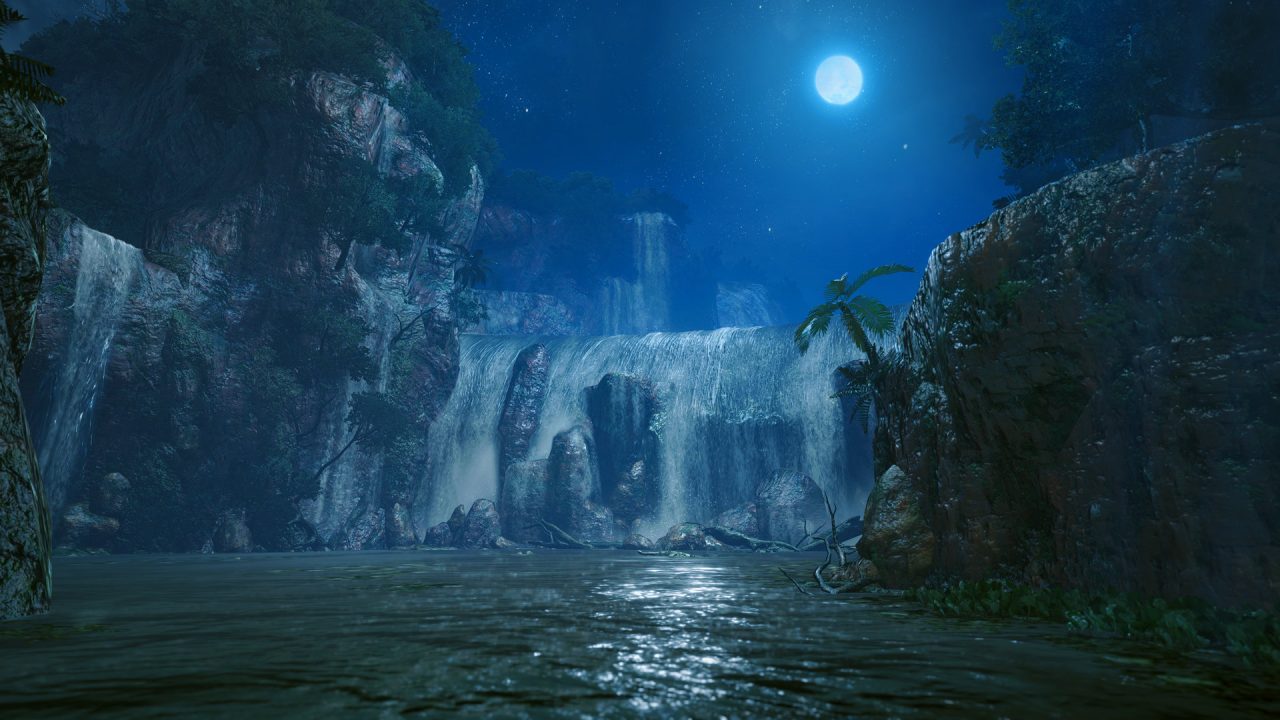As much as I have steeled myself against hype for new releases over the years, Monster Hunter Rise broke my will in two as soon as it was announced. The previous installment in the Monster Hunter series, World, almost singlehandedly brought me through a crippling low in my love for games, so I couldn’t help feeling giddy about what Rise could bring to the table. But despite the almost electrifying excitement that ran through me as I booted up the game on PC for the first time, a lingering sense of doubt remained. Would Monster Hunter Rise rise to the challenge?
As the second entry into the fifth generation of the Monster Hunter series, Rise carries over many of its predecessor’s modern sensibilities while improving upon them in small but meaningful ways. Now players only have to interact once with gathering spots for all the loot, there isn’t farming for tickets in a separate quest to activate food buffs, and monsters are visible on the map from the get-go, just to name a few. Although I can’t attest to how significant these changes are in the bigger picture of the franchise, they certainly felt like marked improvements over some of the busywork players had to do before hunts in World.
Rise doesn’t just stop with basic quality of life changes: it even revamps core gameplay through the introduction of Wirebugs. Unlike Iceborne’s clutch claw, which served as little more than a basic grappling hook for most gameplay, Wirebugs open an entire range of vertical mobility and powerful movesets for weapons. Silkbinds, unique weapon skills involving the Wirebug, prove to be an especially exciting addition to the already fantastic combat system from World. From setting up powerful counter stances to enabling rapid repositioning in the heat of battle, the added layer of depth and customization granted by these new moves gives the weapons such fluidity as to make World’s moveset feel stiff in comparison. My favorite improvement of the bunch is the hammer’s aerial spinning bludgeon move. It now has a dedicated silkbind to pull you into the air for a satisfying flurry of attacks instead of having to hop off of slopes awkwardly for a similar effect.
In addition to the silkbinds, each weapon receives two switch skills for further combat customization. Admittedly, some of these skills are decidedly more impressive than their alternative, such as the hammer’s first switch skill being a choice between an all-purpose counter vs. a generic side smash, but this is more the exception than the norm.
Wirebug-facilitated wyvern riding replaces mounting here and turns previously cumbersome and irritating monster invasions into an absolute blast. Gone are the days of having to farcaster back to camp for dung pies because a Tigrex barged in on your battle for the fifth time this hunt. Instead, monsters engage in a brief scuffle; afterward, players can grapple onto the loser, briefly wrangle them for a knockdown, and even use some of their moves on the other monster for some decent damage. While this does seem to have toned down the frequency of turf wars, as I have only seen a handful of them over my playtime, losing a bit of cinematic flair for these gameplay touch-ups is a tradeoff I am happy with.

Quests this time around are much easier to distinguish from one another. Instead of having to bumble through four optional quest types without any real way to differentiate them, Rise bundles all of its quests into star levels based on the difficulty of each hunt. Mandatory quests are marked within each tier, and players can skip one or two quests per tier and still progress the story. Quests have two categories: entry-level Village quests and more advanced Gathering Hub quests. Don’t let the ease of the village quests fool you, however, as the bulk of the story lies in the hub quests after the initial ten hours or so. Going into the hub quests without at least some mastery over your weapon(s) of choice will only end in frustration and little actual progress.
This isn’t to say that all the new additions have worked out quite so well. Rampage mode, Rise’s attempt at a tower-defense game, for example, is a chore to play solo. It turns into a chaotic affair with the slew of monsters you’re required to defeat per wave, especially early on when you’re still learning the ropes of the game. The fact that these quests are required at certain points to progress through the story only serves to point out how tedious they really are. I couldn’t glean much enjoyment out of playing them even after acquiring much higher quality gear. I’m sure these issues will be alleviated when playing with a group of friends or even just a friendly lobby of strangers, but my single-player experience in the early release version of Rise has been disappointing.

The endgame still feels half-baked on PC despite including all the current post-launch title updates. I did find farming for monster parts to be melded into talismans a much more palatable experience over World’s non-stop high-tier tempered hunts for decorations. But the lack of investigations — freeform hunts with randomized conditions and locales — results in an overall stale gameplay loop. Going to the same areas to hunt monsters that spawn in the same one or two locations every time gets old quickly, and I can’t help but hope some form of investigations return with the upcoming Sunbreak expansion.
Hunts themselves also feel a little too easy this time around. While players enjoy a plethora of powerful new moves and mobility options, the monsters have gained hardly anything at all to level the playing field. Committing to attacks at the wrong time has turned from a lethal mistake to a mild inconvenience for all but a handful of hunts, and the tension it ends up draining from later fights becomes more and more noticeable as you settle into the late gameplay loop.
Map design overall has also been somewhat of a disappointment despite Wirebugs facilitating a variety of vertical exploration options. Being able to venture into nooks and crannies that were otherwise relegated to set dressings previously is undoubtedly a cool experience, but the overall feel of a living, breathing ecosystem is oddly absent. This isn’t to say that I was expecting World levels of immersion, especially given the Switch’s hardware limitations, but the locales this time around simply feel like large arenas to fight the monsters in. However, I do appreciate the greater role that endemic life plays in Rise. From spiribirds that grant various buffs for that specific hunt to bugs and critters you can utilize in the fight itself with various effects, Rise manages to at least provide enticing gameplay incentives for players to explore the map first instead of beelining it straight to the monster.

But one thing that most definitely did not fall short of my expectations is the art direction in Rise. Adopting a more Japanese aesthetic, Rise is an absolutely gorgeous game to look at. From the sakura trees that adorn the various buildings in Kamura Village to the more Eastern leanings of the armor and monster design, the thematic cohesion of the visuals proves to be just as compelling as the fidelity of the game itself. Additionally, Rise runs wonderfully on the PC; I never experienced so much as a blip in framerate during my playtime. Admittedly, I never really pushed the game beyond 100 FPS at 1080p, but I have no doubts that it would run just as smoothly at 4K given that your rig is up to the task.
Sound design is incredible as well, from the guttural roars of the monsters to the delicate vocal melodies of Kamura Village. Traditional Japanese instrumentation adds a distinct flair to many monster themes both new and old, and ends up fitting snugly with the overall aesthetic direction. Whatever Rise might’ve lacked in terms of worldbuilding-based gameplay, it more than makes up for with its inspired soundscape.
A hundred hours in, Rise does feel a little rote. The lack of quest variety and endgame options besides grinding for talismans has begun to wear on me somewhat. But the journey of getting to this point has been nothing short of an incredible experience. From zipping through the air to bludgeon monsters in the face to setting out on gathering runs with my trusty palamute, the minute-to-minute gameplay of Rise is impeccable. The only real issue with Rise is that there isn’t more of it, but with plenty of future updates and an entire expansion on the horizon, this is surely just the beginning of what this game has to offer.




